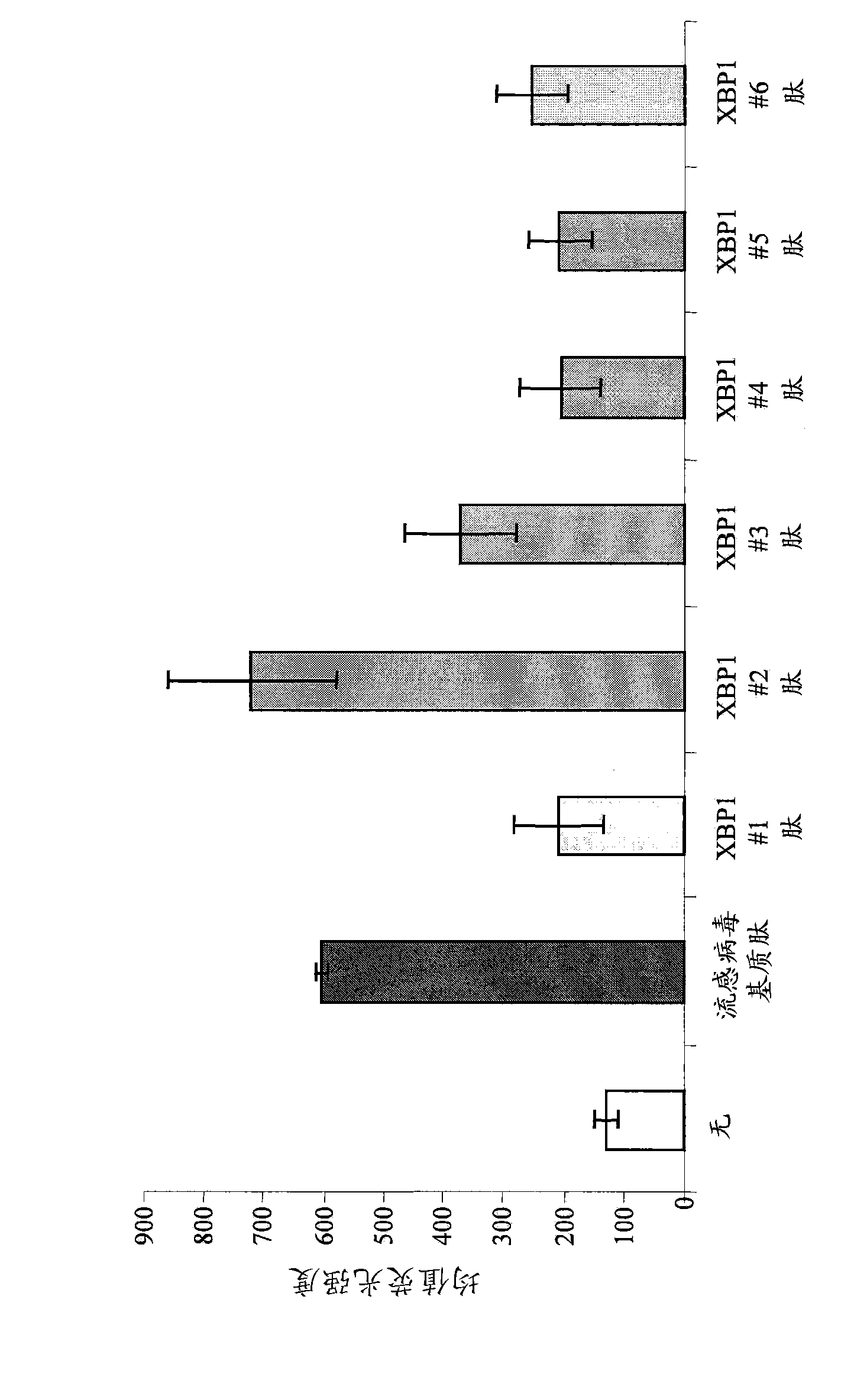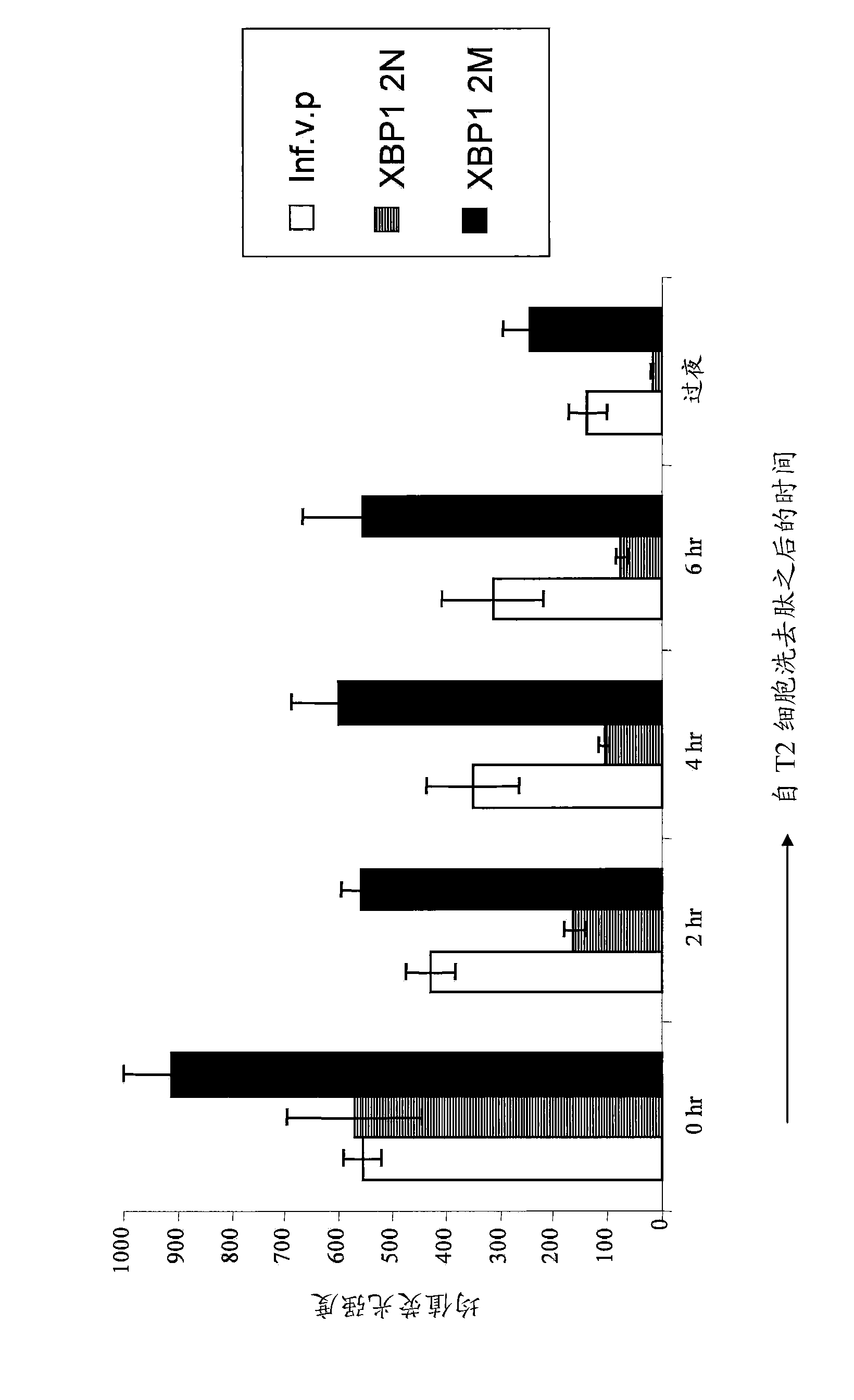XBP1, CD138, and CS1 peptides
A composition and drug technology, applied in the fields of peptides, specific peptides, peptide/protein components, etc., can solve problems such as poor prognosis of patients
- Summary
- Abstract
- Description
- Claims
- Application Information
AI Technical Summary
Problems solved by technology
Method used
Image
Examples
Embodiment 1
[0231] Example 1: Materials and methods
[0232] cell line. Human multiple myeloma cell lines: McCAR, MM1S and U226 were obtained from the American Type Culture Collection (ATCC; Manassas, VA). The human acute myeloid leukemia (AML) cell line ML-2 was kindly provided by Dr. Y Matsuo (Fujisaki Cell Center, Okayama, Japan). The T2 cell line, which is a hybrid of human B and T cells expressing the HLA-A2.1 molecule (Zweerink et al., (1993) J Immunol. 150(5): 1763-71), was developed by Dr.J.Molldrem (University of Texas M.D. Anderson Cancer Center, Houston, TX) and was used as a source of antigen presenting cells (APCs). All cell lines were cultured in RPMI-1640 medium (Gibco-Life Technologies, Rockville, MD).
[0233] Reagent . Mouse anti-human CD80 or CD83 monoclonal antibody (mAb) conjugated to phycoerythrin (PE) was purchased from Immunotech (Hialeigha, FL). Specific for CD3, CD4, CD8, CD14, CD40, CD45RA, CD45RO, CD69, CD80, CD83, CD86, CCR7, HLA-A2, and HLA-DR conju...
Embodiment 2
[0249] Example 2: XBP1 184-192 (NISPWILAV) and spliced XBP1 367-145 (ELFPQLISV) Peptide Display High affinity / stability for HLA-A2 binding
[0250] The full-length sequence of unspliced or spliced XBP1 protein (see above) was analyzed to predict specificity for HLA-A2 using the search software SYFPEITHI (database of MHC ligands and peptide motifs, Institute for Cell Biology, Department of Immunology, Heidlberg) Peptides that were neutral were followed by the BIMAS program to select peptides with prolonged half-time off-rates. A total of six potential HLA-A2 binding native peptides were selected from the unspliced XBP1 protein, as follows: XBP1 117-125 (LLREKTHGL (SEQ ID NO: 1); XBP1 #1 peptide), XBP1 184-192 (NISPWILAV (SEQ ID NO: 2); XBP1 #2 peptide), XBP1 189-197 (ILAVLTLQI (SEQ ID NO: 3); XBP1 #3 peptide), XBP1 192-200(ILAVLTLQI (SEQ ID NO: 4); XBP1 #4 peptide), XBP1 110-118 (KLLLENQLL (SEQ ID NO: 5); XBP1 #5 peptide), and XBP1 93-101 (RMSELEQQV (...
Embodiment 3
[0254] Example 3: XBP1-CTLs display a distinct phenotype from unstimulated T cells
[0255] Cytotoxic T lymphocytes (CTLs) are phenotypically defined by the expression of unique cell surface antigens such as CD8. Cell surface antigens can also be used to further define CTLs as naive or activated memory cells. For example, naïve human CTL can pass CD45RA + / CCR7 + is defined by the presence of CD69, while activated human memory cells can be defined as CD69 + / CD45RO + to identify. Flow cytometry was performed on scrambled peptide-stimulated human T cell populations to determine the percentage of naive or activated memory cells in CTL. Figure 5 showed that CTLs stimulated with XBP1 irregular peptides induced a significantly higher percentage of CD8 compared to unstimulated T cell cultures (33%) + T cells (unspliced peptide stimulated: 81%; spliced peptide stimulated: 75%), and a lower percentage of CD4 compared to unstimulated T cell cultures (64%) + T cells (unspl...
PUM
 Login to View More
Login to View More Abstract
Description
Claims
Application Information
 Login to View More
Login to View More - R&D
- Intellectual Property
- Life Sciences
- Materials
- Tech Scout
- Unparalleled Data Quality
- Higher Quality Content
- 60% Fewer Hallucinations
Browse by: Latest US Patents, China's latest patents, Technical Efficacy Thesaurus, Application Domain, Technology Topic, Popular Technical Reports.
© 2025 PatSnap. All rights reserved.Legal|Privacy policy|Modern Slavery Act Transparency Statement|Sitemap|About US| Contact US: help@patsnap.com



